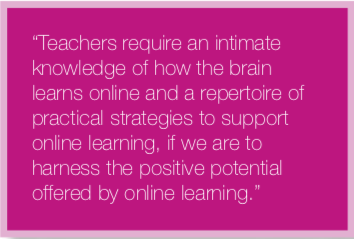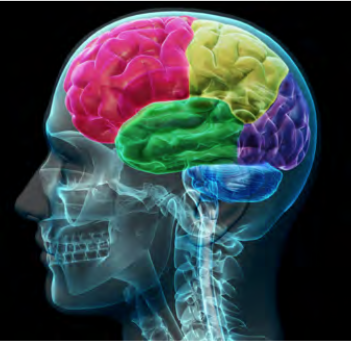Realistic Strategies to Support Online Learning

Neuroscience tells us that the brain learns online in vastly different ways than it does with face-to-face learning with a teacher. Delivering quality online learning experiences, as many schools have been thrust into with the global health pandemic, requires an understanding of how the brain learns in an online context. It’s not a matter of simply ‘digitalising’ traditional teaching approaches or replicating analogue learning experiences online.
In the How the Brain Learns Online virtual masterclass for teachers, I outline the twelve brain-based principles to support online learning, as underpinned by neuroscience. In this article, I’ll outline three key brain-based principles and simple strategies to support online learning. Teachers require an intimate knowledge of how the brain learns online and a repertoire of practical strategies to support online learning, if we are to harness the positive potential offered by online learning.

1. Work in Sprints – Not Marathons
Teachers (and parents) shouldn’t expect students to focus online for long periods of time. The brain tires very quickly when engaging in online learning because it is cognitively taxing. This is why many of us have experienced ‘Zoom fatigue.’ There are a lot of sensory stimuli that the brain has to process online (audio, animations, static and dynamic graphics, text — not to mention the background happenings on video conference calls). This places extra demands on the sensory cortices of the brain.
In addition, when students are learning online, their prefrontal cortex, which is the impulse-control centre of the brain, has to work harder so they can resist digital distractions. For example, students have to resist the temptation to open up another Internet browser when they’re supposed to be completing an online quiz, dismiss the urge to check social media when listening to a class conference call, or not focus on what’s happening in the background of their classmate’s Zoom window. There is so much vying for students’ attention online, so their prefrontal cortex can become depleted very quickly.
We also know that students tend to remember the beginning and the end of a lesson, whether they’re learning online or
in person. This is called the ‘primacy’ and ‘recency’ principle. However, this can be amplified when learning online, especially if their attention starts to wane. They tend to forget much of the middle component of a lesson. If we work in shorter sprints, we’re effectively creating more beginnings and endings so this will help with the retention of information.
Tip: Encourage students to work in shorter bursts online. There’s a reason TED talks are only 18 minutes! 20 minutes is usually the maximum time frame you could expect for focused attention online, with maximum attention usually occurring between the fifth and fifteenth minutes, depending on the age of students and the task at hand. Schedule regular breaks as these will have a restorative impact on the brain and will improve retention of information. If you need to deliver longer lessons, can you intersperse some physical movement into your lessons? Movement will allow the brain to release dopamine which will help their focus. Ensure that students don’t fatigue prematurely by encouraging them to eat and drink regularly. 20-25% of the body’s total energy budget goes towards running their brain. Look for simple design when selecting apps, websites and software. Too many bells and whistles will distract and exhaust students’ prefrontal cortex.
2. Break Information Into Chunks
The online world can be overwhelming for many of us, as there is so much information online. This can be referred to as ‘infobesity.’ When delivering online learning experiences, teachers need to minimise the feeling of infobesity and help students break down information into manageable chunks.
The brain’s memory centre, the hippocampus, has a holding capacity. Previous research indicated that students could hold seven plus or minus chunks in their head. This was their capacity for working memory. However, that science is outdated, and new research suggests that the brain can hold two to four chunks of information. This requires the delivery of concepts and skills to students in chunks. This will make their learning more manageable and will make it easier to integrate it into their long-term memory.
Tips: Deliver lessons and learning experiences into small chunks, where two to four pieces of information are presented at any one time. Encourage students to use graphic organisers such as t-charts, concepts maps or knowledge webs to demonstrate and organise their learning. Organise content on the screen into a scannable and easily digestible form (use checklists and flowcharts, for example). Use quizzes, polls and interactive chats to assess small chunks of information so you can pinpoint gaps in their skills or knowledge.
Our brain’s preference for visuals is evidenced by our ability to remember faces, not names. Of all the information the brain absorbs, around 80-90% is visual. If students hear information, three days later they’ll remember around 10% of it. However, if we pair the information with a visual, they’ll remember 65%. One of the easiest ways to ensure that students store information in their long-term memory is to pair concepts with meaningful images. Visuals help students make sense out of the content and direct attention, increasing retention rates. This is one of the key affordances of online learning – we can deliver high-quality visual content.

Tips: Use visual content in online lessons to convey ideas with images, infographics, animations, videos or diagrams. Encourage students to create visual content to convey their knowledge with concept mapping software, illustrations and infographics such as Canva. Tell stories and use visuals in your online teaching to activate their visual cortex.
